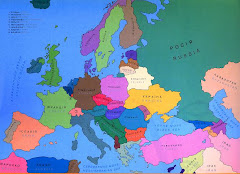


At our weekly English Club on Sunday we expanded on our February theme of Love to cover the world. We looked at our large map of the world and identified continents, oceans, countries, warm climates, cold climates. Then we made a global village using a powerpoint presentation shared by my PCV friend Barb Weiser in Simferopol, Crimea. I just printed out the colorful slides and used those. It went like this:
If you could fit the entire population of the world into a village consisting of 100 people, maintaining the proportions of all the people living on Earth, that village would consist of:
*57 Asians
*21 Europeans
*14 Americans (North, Central and South)
* 8 Africans
We took turns reading, repeated words and ideas, talked about our village. We recognized that the 14 "Americans" could be Caucasion, of African descent, Spanish-speaking, French-speaking, native Americans and Eskimos, Asians, and a combination of these. We talked about the complexites, and also the implications, some of which caught us by surprise.
*57 Asians
*21 Europeans
*14 Americans (North, Central and South)
* 8 Africans
We took turns reading, repeated words and ideas, talked about our village. We recognized that the 14 "Americans" could be Caucasion, of African descent, Spanish-speaking, French-speaking, native Americans and Eskimos, Asians, and a combination of these. We talked about the complexites, and also the implications, some of which caught us by surprise.
In our village there would be:
*52 women and 48 men
*30 Caucasians and 70 non-Caucasians
*30 Christians and 70 non-Christians
*89 heterosexuals and 11 homosexuals.
* 6 people would possess 59% of the wealth
*70 would live in poverty
*70 would be illiterate
* 1would be dying
* 1 would be being born
* 1 would own a computer
* 1 would have a university degree.
Some of these statistics astounded. So many living in poverty? Only 1 with a computer? Could this be? We wondered about these numbers; we thought some of these figures might be wrong and some impressions might not be quite right. Some were hard to believe.
But we all agreed that this global village was something to think about. Sometimes we live in our own little world and forget about the larger world we share on planet earth. My theme was we need to love the earth and extend our love to people different than us. This is not easy to do, but if we can try we will have a more peaceful, caring world. We will be fighting poverty and ignorance, not each other.
I passed out the flags of the world, which everybody found fascinating-- there are lots of them (some 13 pages printed out!). Some look alike, some are very beautiful, some simple like Ukraine's flag. Many contain symbols of the nation they represent, like the maple leaf on the Canadian flag. Many have stars and stripes. Everyone chose a few flags to cut out, put on pieces of color paper that say something about the country, and put them up on our HUMAN FAMILY TREE.
Since I drew the tree, it wasn't very pretty, but it was beautiful after members got done with their flag decorations. They put nice descriptive words on their decorations. France: Eifel Tower, the Louvre. Britain, big ben; Ireland,green; Germany, modern; Canada, ice hockey.; Italy, the boot. Ukraine, blue sky above, yellow fields below. Turkmenistan, former Soviet Republic, beautiful flag. There were several former Soviet Republics, now independent nations. Irag, Iran, Middle Eastern countries, oil and war and poverty. African countries, wild animals, poverty, desert. Asian countries: China the most people; Japan, islands. We did a good job of covering the world.
As we were about to take a photo of our Human Family Tree, Tonya jumped up and said, "Wait! Where is the United States? Who has the United States?"
Silence. The members looked frantically through the pages of flags looking for the flag of the US. I assured them it was okay; we didn't have to have the US on the tree, but the members were now united in one voice. We must have the flag of the United States! We waited for Tonya to make her decoration: It was a red heart with the US flag in the middle. It was very touching. Now we were ready to take our photo (Tonya, far left, holding heart). "We are the World!"




























No comments:
Post a Comment